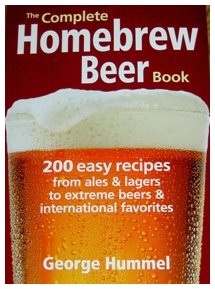The Complete Homebrew Beer Book - Review

 Perhaps you have been intrigued with the mystery of homebrewing. It seems like something you would like to do, but until you get networked with a group of actual brewers, you are not quite sure you can craft a successful beer. For many, an intimidation factor makes it difficult to start. Books by Charlie Papazian encourage you to "Relax! Don’t Worry! Have a Homebrew!” while Ray Daniels tells you how to design a great beer, but some of the information seems to assume you already have a basic understanding of beer styles or tosses around information and formulas at rocket speed. All too often, simple directions use jargon that just doesn’t translate in your brain.
Perhaps you have been intrigued with the mystery of homebrewing. It seems like something you would like to do, but until you get networked with a group of actual brewers, you are not quite sure you can craft a successful beer. For many, an intimidation factor makes it difficult to start. Books by Charlie Papazian encourage you to "Relax! Don’t Worry! Have a Homebrew!” while Ray Daniels tells you how to design a great beer, but some of the information seems to assume you already have a basic understanding of beer styles or tosses around information and formulas at rocket speed. All too often, simple directions use jargon that just doesn’t translate in your brain.
If you are a woman, you may have noticed that the world of homebrewing is dominated by men, so you may be even more hesitant to start. Although brewing beer runs parallel to the same skills used in cooking, the equipment – with its air locks, carboys and hydrometers – seems to mimic the world of chemistry, and brings back memories of those dreaded high school finals. It simply is not the same as baking brownies. If you could get guidance from an expert homebrewing authority, it would make all the difference in the world.
Now, you can. The Complete Homebrew Beer Book, by George Hummel, sets the bar among homebrew books with directions and recipes that provide a direct path to successful brewing, with no bull … period.
Since 1986, George Hummel and his wife Nancy Rigberg, have been supplying homebrewers and Philly tourists with supplies to make beer, wine, and ciders from their shop, Home Sweet Homebrew, in the heart of Philadelphia, Pennsylvania. In collaboration with Gordon Grubb, Master Brewer at Nodding Head Brewery, George designed a Specialty Honey Beer called George’s Fault, which won a gold medal at Denver’s 2005 Great American Beer Festival, the grand-daddy of beer competitions in the USA.
George Hummel is an experienced BJCP judge, and a columnist for Mid-Atlantic Brewing News. He has taught courses on beer and brewing at Temple and Drexel Universities, and has led seminars at local beer festivals. In 2008, George and Nancy were recipients of the Governor's Inspiration Award, presented by Governor Ed Rendell of Pennsylvania, and were inducted into the Keystone Society of Tourism in Gettysburg.
The Complete Homebrew Beer Book – Review Details I received a much anticipated review copy of George’s book directly from the publisher, Robert Rose, of Toronto, Canada. My first impression was that this was no ordinary book on beer and brewing. If I were to use American slang, I would say it cut to the chase. In an easy, conversational style, George presents homebrewing with all the essentials. In fact, he does it so clearly that he leaves nothing as a question in the reader’s mind. In simple language, he explains how to remove chemicals from water while still preserving its mineral content (and why you should), or where to lay equipment after it has been sanitized. He clearly explains primary, secondary and tertiary racking, what equipment is necessary vs. nice, and what products work best under specific circumstances. There is no need to get hung-up on the details, because George covers all those crazy things that make people hesitate.
I received a much anticipated review copy of George’s book directly from the publisher, Robert Rose, of Toronto, Canada. My first impression was that this was no ordinary book on beer and brewing. If I were to use American slang, I would say it cut to the chase. In an easy, conversational style, George presents homebrewing with all the essentials. In fact, he does it so clearly that he leaves nothing as a question in the reader’s mind. In simple language, he explains how to remove chemicals from water while still preserving its mineral content (and why you should), or where to lay equipment after it has been sanitized. He clearly explains primary, secondary and tertiary racking, what equipment is necessary vs. nice, and what products work best under specific circumstances. There is no need to get hung-up on the details, because George covers all those crazy things that make people hesitate.
Anyone who has contemplated brewing has heard horror stories about boil-overs, not having big enough pots, or cleaning out whole-grain and hop sludge after mashing, even when only a small amount was used. George explains what causes these situations, and offers practical solutions for every one of them – so well, that you feel he is in your kitchen with his brotherly support. In little sidebars, he even gives tips and suggestions about equipment, yeast, sanitizing oak chips, and milling your own grain. He also provides sidebars with brief explanations about each beer style, the original gravities, and a short equipment list. He does not confuse the brewer with any numbers for final gravity, but does clearly explain how to determine that fermentation is complete.
The book is divided into Part One for novices, followed by Part Two for more advanced homebrewers – using whole grains in conjunction with malt extracts. He provides charts of Brewing Gear and Supplies, with columns that list essential equipment vs. helpful, but not necessary, equipment. He even provides a Brew Day Process Summary, laid out in the order in which you need to do each task.
As the material becomes more complex, he presents charts to categorize malts and hops, along with the countries of origin and characteristics of each. He provides chapters of beer recipes specific to these countries, making it easy to understand a favorite style, or how local ingredients or water profiles drove style-development in Belgium, Germany, the Czech Republic, France, the British Isles, or North America. He then returns to the beginner recipes from Part One, modified to include the use of whole grains to enhance flavor.
Part Three really soars, focused on beers that may be viewed as weird or extreme – George’s words, not mine! It’s all part of his easy-going style. He does not touch on beers that are crafted using unusual “processes,” (like stein beer, fire-brewed beer, or Stingo beer), but on unusual or exotic “ingredients” that make brewing both fun and creative. These exotics include Gruit, Sahti, Wassail, Grodzinsky, Rauchbier, Berliner Weisse, Gueuze, Fruit Beer, and even Gluten Free Beers for the Celiac population.
He also immerses you in Wheat Wines, Mead, and Cider. For the younger set, homebrewed root beer, ginger ale, and birch beer round up the tail end of the book. A Glossary, with illustrations for the more obscure pieces of equipment, is included.
Hummel does include Irish Moss as a clarifying agent in nearly all recipes in the book, except for those that traditionally retain yeast or are flavored by delicate herbs, orange peel, or apple, such as Bavarian Hefeweisen, Witbier, or Cider. Although other products can clear beer haze, simplicity and economics makes this an ideal choice.
Yeast nutrient is also used in all recipes in this book, a practice not shared by all in the brewing community. Hummel’s brewing philosophy runs counter to that of Charlie Papazian, author of The Complete Joy of Home Brewing. Papazian cautions against using yeast nutrients because, although it helps yeast do its work, beer can then exhibit less sweetness, less body, less head retention, and more alcohol. But under-attenuated beer is not good either, and Hummel's advice supports that philosophy.
George Hummel strongly recommends that you keep a detailed journal of your brewing, including personal preferences, successes and bumps along the way. Your own experience will guide you whether to use certain ingredients or forego them. As George says, “All this information helps you decide what to use in your brew.”
“Flavor creates passion. So be passionate about your beer.”
Cheers!
Want your own copy? Get it now.
The Complete Homebrew Beer Book: 200 Easy Recipes, from Ales and Lagers to Extreme Beers and International Favorites
Photos are (from top): The Complete Homebrew Beer Book by George Hummel; George Hummel, author of The Complete Homebrew Beer Book
You Should Also Read:
It's George's Fault at Home Sweet Homebrew
Homebrew Tips for the Novice Brewer
Homebrewing - Gross Inspiration

Related Articles
Editor's Picks Articles
Top Ten Articles
Previous Features
Site Map
Content copyright © 2023 by Carolyn Smagalski. All rights reserved.
This content was written by Carolyn Smagalski. If you wish to use this content in any manner, you need written permission. Contact Carolyn Smagalski for details.



